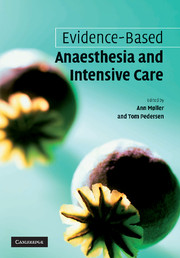Book contents
- Frontmatter
- Contents
- Foreword
- Contributors
- 1 Introducing evidence-based anaesthesia
- 2 How to define the questions
- 3 Developing a search strategy, locating studies and electronic databases
- 4 Retrieving the data
- 5 Critical appraisal and presentation of study details
- 6 Outcomes
- 7 The meta-analysis of a systematic review
- 8 Bias in systematic reviews: considerations when updating your knowledge
- 9 The Cochrane Collaboration and the Cochrane Anaesthesia Review Group
- 10 Integrating clinical practice and evidence: how to learn and teach evidence-based medicine
- 11 Involving patients and consumers in health care and decision-making processes: nothing about us without us
- 12 Evidence-based medicine in the Third World
- 13 Preoperative anaesthesia evaluation
- 14 Regional anaesthesia versus general anaesthesia
- 15 Fluid therapy
- 16 Antiemetics
- 17 Anaesthesia for day-case surgery
- 18 Obstetrical anaesthesia
- 19 Anaesthesia for major abdominal and urological surgery
- 20 Anaesthesia for paediatric surgery
- 21 Anaesthesia for eye, ENT and dental surgery
- 22 Anaesthesia for neurosurgery
- 23 Cardiothoracic anaesthesia and critical care
- 24 Postoperative pain therapy
- 25 Critical care medicine
- 26 Emergency medicine: cardiac arrest management, severe burns, near-drowning and multiple trauma
- Glossary of terms
- Index
24 - Postoperative pain therapy
Published online by Cambridge University Press: 05 September 2009
- Frontmatter
- Contents
- Foreword
- Contributors
- 1 Introducing evidence-based anaesthesia
- 2 How to define the questions
- 3 Developing a search strategy, locating studies and electronic databases
- 4 Retrieving the data
- 5 Critical appraisal and presentation of study details
- 6 Outcomes
- 7 The meta-analysis of a systematic review
- 8 Bias in systematic reviews: considerations when updating your knowledge
- 9 The Cochrane Collaboration and the Cochrane Anaesthesia Review Group
- 10 Integrating clinical practice and evidence: how to learn and teach evidence-based medicine
- 11 Involving patients and consumers in health care and decision-making processes: nothing about us without us
- 12 Evidence-based medicine in the Third World
- 13 Preoperative anaesthesia evaluation
- 14 Regional anaesthesia versus general anaesthesia
- 15 Fluid therapy
- 16 Antiemetics
- 17 Anaesthesia for day-case surgery
- 18 Obstetrical anaesthesia
- 19 Anaesthesia for major abdominal and urological surgery
- 20 Anaesthesia for paediatric surgery
- 21 Anaesthesia for eye, ENT and dental surgery
- 22 Anaesthesia for neurosurgery
- 23 Cardiothoracic anaesthesia and critical care
- 24 Postoperative pain therapy
- 25 Critical care medicine
- 26 Emergency medicine: cardiac arrest management, severe burns, near-drowning and multiple trauma
- Glossary of terms
- Index
Summary
Opioid analgesics have long been the mainstay of postoperative pain management. Although effective, their usefulness is offset by opioid-related side effects such as nausea and vomiting, sedation, and bowel and bladder dysmotility, all of which can delay the return to normal physiologic functioning after surgery. In this chapter we review alternative and adjunctive modes of delivering postoperative analgesia and summarise what is known about efficacy and outcome. Current evidence demonstrates convincingly that epidural analgesia, patient-controlled analgesia (PCA), and adjuncts (non-steroidal anti-inflammatory drugs (NSAIDs), acetaminophen, and gabapentin) improve postoperative analgesia and patient satisfaction. Each of these modalities (except PCA) show a measurable opioid-sparing effect, but the reduction of opioid intake although theoretically beneficial, has not consistently been shown to improve outcome and recovery. Epidural analgesia does offer a number of distinct benefits that hasten recovery. Its use has not however been shown to reduce mortality. It is unclear at this point whether pre-emptive interventions can affect postoperative outcome, but the evidence is increasingly supporting this approach for certain treatments (epidural analgesia, local anaesthetics, NSAIDs, and gabapentin). The current trend in postoperative analgesia is a movement towards a multimodal approach of treating pain throughout the perioperative period.
In the last two decades efforts have been made to promote evidence-based guidelines for postoperative pain management [1].
Keywords
- Type
- Chapter
- Information
- Evidence-based Anaesthesia and Intensive Care , pp. 307 - 320Publisher: Cambridge University PressPrint publication year: 2006



